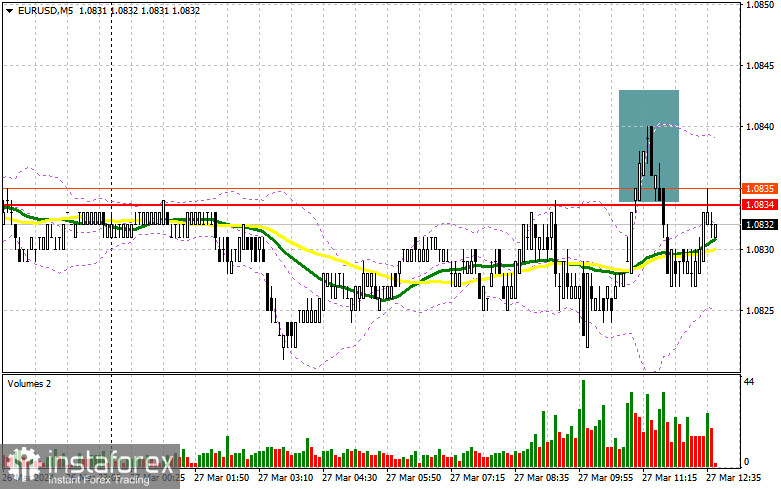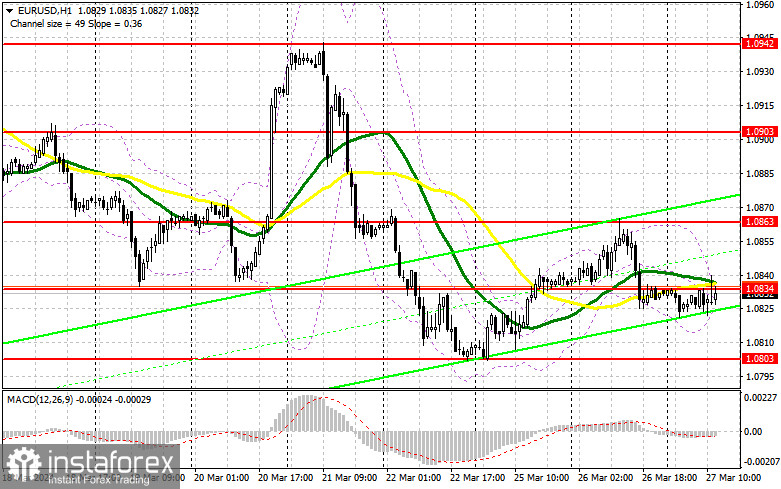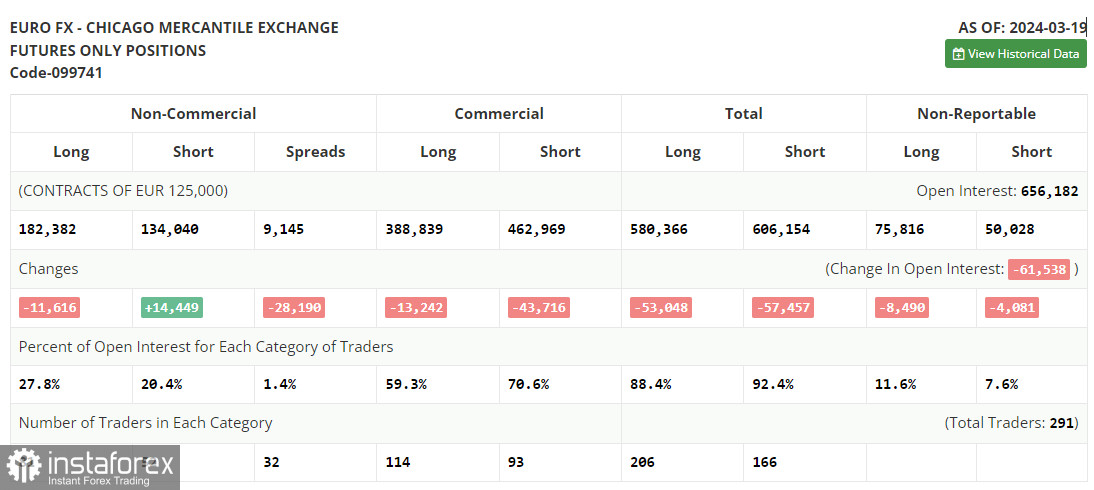In my morning forecast, I focused on the level of 1.0834 and planned to make trading decisions based on it. Let's look at the 5-minute chart and analyze what happened there. The rise and the formation of a false breakout led to a selling signal, but, as you can see on the chart, there was no significant downward movement due to the low volatility, which was expected. The technical picture remained unchanged for the second half of the day.

For opening long positions on EURUSD, the following is required:
There are no US statistics ahead of us, as there was in the morning for the Eurozone, so it isn't easy to count on anything. Most likely, if there is any movement, it will not be strong. The trend is downward, so I will rely on it and on buying after the pair declines, forming a false breakout around the support area of 1.0803. Only this will be a suitable option for long positions, counting on another correction towards 1.0834 – resistance formed due to yesterday's session, where moving averages, favoring sellers, intersect. Breaking and updating this range from top to bottom will strengthen the pair with a chance to surge to 1.0863. The ultimate target will be a maximum of 1.0903, where I will take profit. In the case of further decline of EUR/USD and lack of activity around 1.0803 in the second half of the day, pressure on the euro will only intensify, leading to further decline with the prospect of updating to 1.0763. I plan to enter the market there only after the formation of a false breakout. I will open long positions immediately on a rebound from 1.0735 with a target of an upward correction of 30-35 points within the day.
For opening short positions on EURUSD, the following is required:
Euro buyers try to return to the market, but it doesn't look easy. As long as trading is conducted below 1.0834, I will expect the realization of short positions based on the morning signal. In case of another pair's rise, the formation of a false breakout around 1.0834 will prove the presence of large sellers in the market and provide another entry point for short positions with the prospect of updating the new support at 1.0803. Breaking and consolidating below this range and a reverse test from bottom to top will provide another selling point with a plunge of the pair to around 1.0763, where buyers will start to act more actively. The ultimate target will be a minimum of 1.0735, where I will take profit. In case of upward movement of EUR/USD in the second half of the day and the absence of bears at 1.0834, buyers will have a chance to lock the pair in a sideways channel. In this case, I will postpone selling until the next resistance test at 1.0863. I will also sell there, but only after an unsuccessful consolidation. I plan to open short positions immediately on a rebound from 1.0903 with a target of a downward correction of 30-35 points.


Indicator Signals:
Moving Averages
Trading is conducted below the 30 and 50-day moving averages, indicating an attempt to decrease the euro.
Note: The period and prices of moving averages considered by the author are on the hourly chart H1 and differ from the general definition of classic daily moving averages on the daily chart D1.
Bollinger Bands
In case of a decline, the lower boundary of the indicator, around 1.0820, will act as support.
Description of Indicators
- Moving average (determines the current trend by smoothing volatility and noise). Period 50. Marked in yellow on the chart.
- Moving average (determines the current trend by smoothing volatility and noise). Period 30. Marked in green on the chart.
- MACD indicator (Moving Average Convergence/Divergence). Fast EMA period 12. Slow EMA period 26. SMA period 9.
- Bollinger Bands. Period 20.
- Non-commercial traders - speculators such as individual traders, hedge funds, and large institutions using the futures market for speculative purposes and meeting certain requirements.
- Long non-commercial positions represent the total long open position of non-commercial traders.
- Short non-commercial positions represent the total short open positions of non-commercial traders.
- The total non-commercial net position is the difference between non-commercial traders' short and long positions.





















